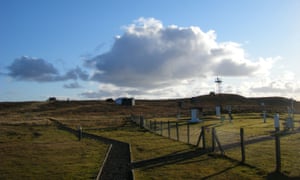
Cold war atomic tests led to increased rainfall on Shetland
Posted: 17th May 2020
From the Guardian May 14th
Electric charge released by radiation from nuclear testing thickened clouds thousands of miles away, research finds

Nuclear bombs detonated during the cold war caused atmospheric changes that increased rainfall thousands of miles away, research suggests.
The electric charge released by radiation from atomic tests carried out mostly by the US and Soviet Union in the 1960s led to increased rainfall on Shetland.
Scientists studied historical records from a research station in Scotland to compare days with high and low radioactivity, and found that clouds were visibly thicker and there was 24% more rain on average on days with more radioactivity.
Giles Harrison, aprofessor of atmospheric physics at the University of Reading and lead author of the study, said: “By studying the radioactivity released from cold war weapons tests, scientists at the time learned about atmospheric circulation patterns. We have now reused this data to examine the effect on rainfall.
“The politically charged atmosphere of the cold war led to a nuclear arms race and worldwide anxiety. Decades later, that global cloud has yielded a silver lining in giving us a unique way to study how electric charge affects rain.”
During the cold war arms race, atomic tests were carried out in locations including the Nevada desert in the US and on islands in the Pacific and the Arctic. Despite their remote locations, radioactive pollution spread widely through the atmosphere.
Radioactivity ionises the air, releasing electric charge. Scientists have long thought that this charge modifies how water droplets in clouds combine, potentially affecting droplet size and influencing rainfall, but this is difficult to observe in the atmosphere.
In the study, published in Physical Review Letters, researchers from the Reading, Bath and Bristol universities combined bomb test data with records from Met Office weather stations at Kew, London, and Lerwick on Shetland.
Because of Lerwick’s isolation more than 100 miles north-west of mainland Scotland, it is a good site to observe potential radiation-related rainfall effects because it is relatively unaffected by other sources of anthropogenic pollution.
It is difficult to measure atmospheric electricity on cloudy days, so measurements from Kew – usually sunnier than Lerwick – were used to identify nearly 150 days where there was high or low charge generation over Britain.
The findings will help to show the typical charges possible in natural non-thunderstorm clouds. The scientists believe this could assist cloud-related geoengineering research, which is exploring how electric charge influences rain, and could potentially be used to relieve droughts.
Harrison is leading a project investigating electrical effects on dust and clouds in the United Arab Emirates as part of the country’s “rain enhancement science” programme.